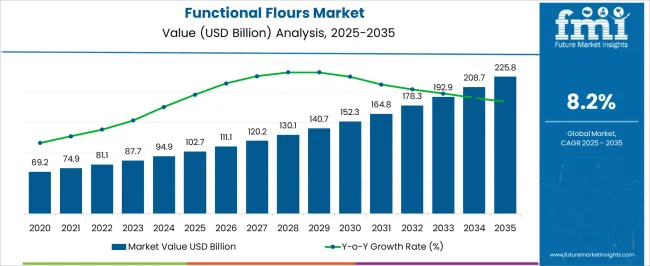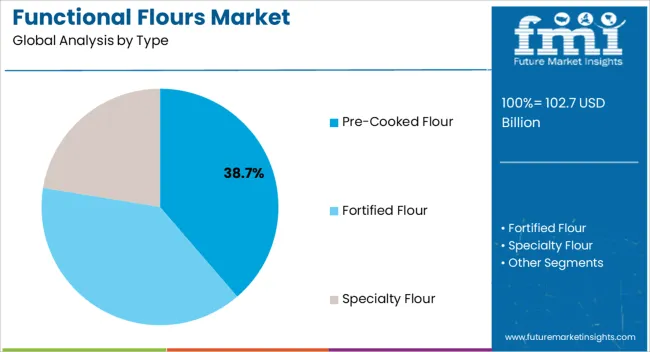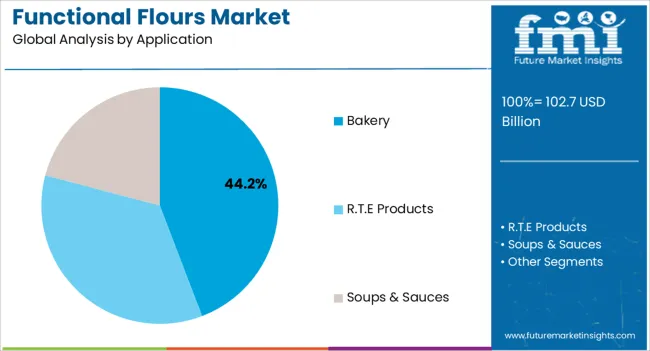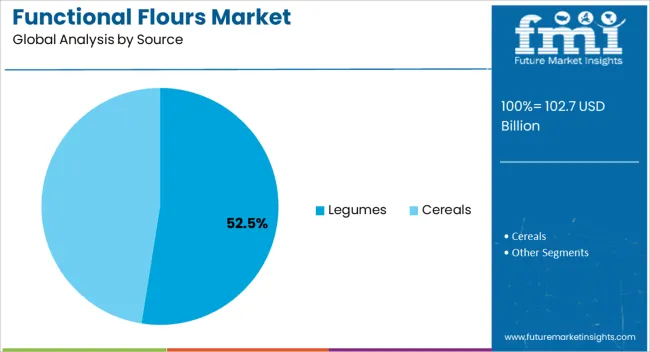The Functional Flours Market is estimated to be valued at USD 102.7 billion in 2025 and is projected to reach USD 225.8 billion by 2035, registering a compound annual growth rate (CAGR) of 8.2% over the forecast period.

| Metric | Value |
|---|---|
| Functional Flours Market Estimated Value in (2025 E) | USD 102.7 billion |
| Functional Flours Market Forecast Value in (2035 F) | USD 225.8 billion |
| Forecast CAGR (2025 to 2035) | 8.2% |
The Functional Flours market is expanding at a steady pace, supported by the rising demand for healthier, nutrient-enriched, and versatile food ingredients. Consumers are increasingly seeking food products that combine convenience with added health benefits, driving adoption of functional flours in bakery, confectionery, ready-to-eat meals, and gluten-free applications. Functional flours are being recognized for their enhanced nutritional profiles, superior digestibility, and suitability for specialized dietary requirements, such as high-protein and gluten-free diets.
The rising prevalence of lifestyle-related diseases, including obesity and diabetes, is further fueling demand for flour variants that improve metabolic health. Technological advancements in flour processing and milling are enhancing product functionality, improving texture, stability, and shelf life, while ensuring retention of essential nutrients. Growing preference for plant-based and clean-label ingredients also plays a pivotal role in shaping consumer purchasing decisions.
In addition, the food industry’s focus on innovation and product differentiation is accelerating the use of functional flours across diverse applications Supported by urbanization, rising health awareness, and premiumization of food products, the market is projected to maintain strong growth momentum in the coming years.
The functional flours market is segmented by type, application, source, and geographic regions. By type, functional flours market is divided into Pre-Cooked Flour, Fortified Flour, and Specialty Flour. In terms of application, functional flours market is classified into Bakery, R.T.E Products, and Soups & Sauces. Based on source, functional flours market is segmented into Legumes and Cereals. Regionally, the functional flours industry is classified into North America, Latin America, Western Europe, Eastern Europe, Balkan & Baltic Countries, Russia & Belarus, Central Asia, East Asia, South Asia & Pacific, and the Middle East & Africa.

The pre-cooked flour segment is projected to account for 38.7% of the Functional Flours market revenue in 2025, making it the dominant product type. Demand for pre-cooked flour is being driven by its versatility, convenience, and ability to improve texture and stability in processed food formulations. These flours are increasingly used in bakery, snacks, sauces, and baby food due to their improved solubility and digestibility.
Manufacturers are adopting pre-cooked flour to enhance the nutritional content of their products while ensuring faster preparation times, aligning with consumer demand for convenience without compromising on health. The growing popularity of gluten-free diets and the rising need for easy-to-digest flours have further supported this segment’s expansion.
Additionally, pre-cooked flour offers functional benefits such as water-binding capacity, thickening ability, and enhanced mouthfeel, which make it a preferred choice across multiple food categories With increasing adoption in both household and industrial applications, coupled with innovations in milling and processing technologies, pre-cooked flour is expected to retain its leadership position in the market.

The bakery segment is expected to hold 44.2% of the Functional Flours market revenue in 2025, establishing itself as the leading application area. Growth is being fueled by the widespread demand for bakery products such as bread, cakes, pastries, and biscuits that offer improved texture, flavor, and nutritional value. Functional flours in bakery applications provide enhanced water absorption, dough stability, and uniformity, resulting in superior end-product quality.
Consumers are increasingly seeking bakery products that are gluten-free, high in fiber, and fortified with proteins, driving the use of innovative flour formulations. The rising trend of healthy indulgence, combined with the rapid expansion of the bakery industry in both developed and emerging markets, is further accelerating this segment’s growth.
Manufacturers are leveraging functional flours to meet the demand for clean-label, non-GMO, and allergen-free bakery products The ability of functional flours to enhance shelf life, retain moisture, and improve sensory attributes is reinforcing their importance in bakery formulations, making the segment a primary contributor to overall market expansion.

The legumes source segment is anticipated to contribute 52.5% of the Functional Flours market revenue in 2025, making it the leading raw material source. This dominance is being reinforced by the rising demand for plant-based proteins and the nutritional richness of legumes, which include lentils, chickpeas, and peas. Legume-based flours are increasingly recognized for their high protein, fiber, and micronutrient content, aligning with the growing trend of health-conscious and vegan diets.
The segment is also benefiting from the surge in gluten-free product development, as legumes provide a natural alternative to traditional wheat flour. Food manufacturers are utilizing legume flours in bakery, snacks, soups, and ready-to-eat meals to improve the nutritional profile of products while maintaining desirable texture and taste.
Advances in flour processing technology have enhanced the functional properties of legumes, enabling better digestibility and reduced anti-nutritional factors As consumer preference shifts toward sustainable, plant-based, and clean-label food products, the legumes segment is expected to remain the dominant source, driving innovation and growth across the Functional Flours market.
Flours are an essential ingredient in pastries, bread, pasta and many more which can be milled through various grains. The protein present in flour creates texture and volume to the batter or dough. Flour is also used to thicken stews, soups, sauces and gravies.
Functional properties of flour include swelling capacity, foam stability, least gelation concentration, and gelatinization. Functional flours provide a natural, luxurious appearance, smooth texture, and reliable flavor to foods from the formation of gluten that provides strength and elasticity.
Functional flours also help in maintain consistency in the procedure and improve processing time. There are two ways to develop functional flours. One is by selecting a particular component from food sources and other is by refining and processing of flours.
Companies are focusing on developing functional flours that have wholesome appeal to the consumer and can align with emerging market trend includes protein and fiber rich, gluten free products. Functional flours are prepared from the process of hydrothermic treatment procedure. The functional flours market is growing at single digit growth over the forecast period.

| Country | CAGR |
|---|---|
| China | 11.1% |
| India | 10.3% |
| Germany | 9.4% |
| France | 8.6% |
| UK | 7.8% |
| USA | 7.0% |
| Brazil | 6.2% |
The Functional Flours Market is expected to register a CAGR of 8.2% during the forecast period, exhibiting varied country level momentum. China leads with the highest CAGR of 11.1%, followed by India at 10.3%. Developed markets such as Germany, France, and the UK continue to expand steadily, while the USA is likely to grow at consistent rates. Brazil posts the lowest CAGR at 6.2%, yet still underscores a broadly positive trajectory for the global Functional Flours Market. In 2024, Germany held a dominant revenue in the Western Europe market and is expected to grow with a CAGR of 9.4%. The USA Functional Flours Market is estimated to be valued at USD 38.1 billion in 2025 and is anticipated to reach a valuation of USD 74.8 billion by 2035. Sales are projected to rise at a CAGR of 7.0% over the forecast period between 2025 and 2035. While Japan and South Korea markets are estimated to be valued at USD 4.7 billion and USD 3.0 billion respectively in 2025.

| Item | Value |
|---|---|
| Quantitative Units | USD 102.7 Billion |
| Type | Pre-Cooked Flour, Fortified Flour, and Specialty Flour |
| Application | Bakery, R.T.E Products, and Soups & Sauces |
| Source | Legumes and Cereals |
| Regions Covered | North America, Europe, Asia-Pacific, Latin America, Middle East & Africa |
| Country Covered | United States, Canada, Germany, France, United Kingdom, China, Japan, India, Brazil, South Africa |
| Key Companies Profiled | Cargill, Inc., Archer Daniels Midland Company, Associated British Foods plc, Ingredion Incorporated, Bunge Limited, Parrish & Heimbecker Limited, Südzucker AG (AGRANA), The Scoular Company, GEMEF Industries, The Caremoli Group, Ulrick & Short, and General Mills, Inc |
The global functional flours market is estimated to be valued at USD 102.7 billion in 2025.
The market size for the functional flours market is projected to reach USD 225.8 billion by 2035.
The functional flours market is expected to grow at a 8.2% CAGR between 2025 and 2035.
The key product types in functional flours market are pre-cooked flour, fortified flour and specialty flour.
In terms of application, bakery segment to command 44.2% share in the functional flours market in 2025.






Our Research Products

The "Full Research Suite" delivers actionable market intel, deep dives on markets or technologies, so clients act faster, cut risk, and unlock growth.

The Leaderboard benchmarks and ranks top vendors, classifying them as Established Leaders, Leading Challengers, or Disruptors & Challengers.

Locates where complements amplify value and substitutes erode it, forecasting net impact by horizon

We deliver granular, decision-grade intel: market sizing, 5-year forecasts, pricing, adoption, usage, revenue, and operational KPIs—plus competitor tracking, regulation, and value chains—across 60 countries broadly.

Spot the shifts before they hit your P&L. We track inflection points, adoption curves, pricing moves, and ecosystem plays to show where demand is heading, why it is changing, and what to do next across high-growth markets and disruptive tech

Real-time reads of user behavior. We track shifting priorities, perceptions of today’s and next-gen services, and provider experience, then pace how fast tech moves from trial to adoption, blending buyer, consumer, and channel inputs with social signals (#WhySwitch, #UX).

Partner with our analyst team to build a custom report designed around your business priorities. From analysing market trends to assessing competitors or crafting bespoke datasets, we tailor insights to your needs.
Supplier Intelligence
Discovery & Profiling
Capacity & Footprint
Performance & Risk
Compliance & Governance
Commercial Readiness
Who Supplies Whom
Scorecards & Shortlists
Playbooks & Docs
Category Intelligence
Definition & Scope
Demand & Use Cases
Cost Drivers
Market Structure
Supply Chain Map
Trade & Policy
Operating Norms
Deliverables
Buyer Intelligence
Account Basics
Spend & Scope
Procurement Model
Vendor Requirements
Terms & Policies
Entry Strategy
Pain Points & Triggers
Outputs
Pricing Analysis
Benchmarks
Trends
Should-Cost
Indexation
Landed Cost
Commercial Terms
Deliverables
Brand Analysis
Positioning & Value Prop
Share & Presence
Customer Evidence
Go-to-Market
Digital & Reputation
Compliance & Trust
KPIs & Gaps
Outputs
Full Research Suite comprises of:
Market outlook & trends analysis
Interviews & case studies
Strategic recommendations
Vendor profiles & capabilities analysis
5-year forecasts
8 regions and 60+ country-level data splits
Market segment data splits
12 months of continuous data updates
DELIVERED AS:
PDF EXCEL ONLINE
Functional Multi-Layer Coextruded Film Market Size and Share Forecast Outlook 2025 to 2035
Functional Plating Chemicals Market Size and Share Forecast Outlook 2025 to 2035
Functional Flour Market Size and Share Forecast Outlook 2025 to 2035
Functional Endoscopic Sinus Surgery Systems Market Size and Share Forecast Outlook 2025 to 2035
Functional Foods Market Size and Share Forecast Outlook 2025 to 2035
Functional Safety Market Size and Share Forecast Outlook 2025 to 2035
Functional Printing Market Size and Share Forecast Outlook 2025 to 2035
Functional Seafood Market Size and Share Forecast Outlook 2025 to 2035
Functional Textile Finishing Agents Market Size and Share Forecast Outlook 2025 to 2035
Functional Water Market Size and Share Forecast Outlook 2025 to 2035
Functional Pet Ingredients Market Analysis - Size, Share, and Forecast Outlook 2025 to 2035
Functional Cosmetic Ingredients Market Size and Share Forecast Outlook 2025 to 2035
Functional Food Ingredients Market Analysis – Size, Share, and Forecast Outlook 2025 to 2035
Functional Flavour Market Analysis - Size, Share, & Forecast Outlook 2025 to 2035
Functional Extracts Market Analysis – Size, Share, & Forecast Outlook 2025 to 2035
Functional Chewing Gum Market Analysis - Size, Share, & Forecast Outlook 2025 to 2035
Functional Carbohydrate Market Analysis -Size, Share, & Forecast Outlook 2025 to 2035
Functional Mushroom Market Size, Growth, and Forecast for 2025 to 2035
Functional Protein Market Analysis - Size, Share, and Forecast Outlook 2025 to 2035
Functional Electrical Stimulation (FES) Market Trends - Growth & Forecast 2025 to 2035

Thank you!
You will receive an email from our Business Development Manager. Please be sure to check your SPAM/JUNK folder too.
Chat With
MaRIA